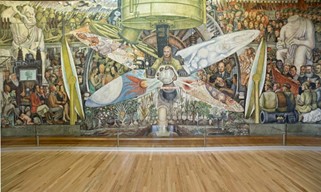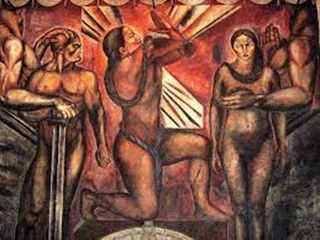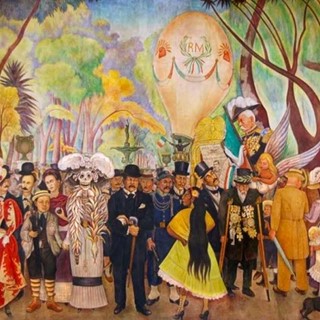

Mexican muralism is one of the most important and influential artistic currents of the 20th century, and has its roots in the Mexican Revolution. At that time, Mexico experienced unprecedented cultural effervescence, and Mexican artists came together to create a new art form that represented the culture and history of the country.
This movement was born as a way to bring art to the masses, and became a powerful tool for education and social awareness.
Today, Mexico City's historic center is where some of the country's most impressive and emblematic murals can be found. From the murals at the Palacio de Bellas Artes to those at the Antiguo Colegio de San Ildefonso, they are a sign of the commitment of Mexican artists to their culture and history. They are a source of inspiration and admiration for those who visit the city.
If you like art and are looking for a unique experience in Mexico City, you can't miss some of the main murals in the historic center. Keep reading as we will tell you which you must see.
Murals of Palacio de Bellas Artes
The Palacio de Bellas Artes (Palace of Fine Arts) is one of the most emblematic buildings in Mexico City, and inside are 12 murals created by some of the main exponents of Mexican muralism: Diego Rivera, David Alfaro Siqueiros, José Clemente Orozco, Rufino Tamayo, Manuel Rodríguez Lozano, Jorge González Camarena and Roberto Montenegro.
While all of them are impressive and worth seeing, the one that stands out the most is Diego Rivera's "The Man Controlling the Universe". This mural has a curious history, as it was originally intended for the Rockefeller Center in New York, but was censored and destroyed on the instructions of the Rockefeller family itself, because they considered its content to be offensive and irreverent. In particular, they found it unacceptable that a portrait of the socialist leader Vladimir Lenin appeared in one of their buildings.

Murals of Antiguo Colegio de San Ildefonso
Housed in a beautiful historic building from the 16th century, San Ildefonso is one of the Mexican capital's best museums of modern and contemporary art.
It is considered one of the cradles of the muralist movement, as its walls are decorated with works by "the big three" (Rivera, Siqueiros and Orozco), and other outstanding artists such as Jean Charlot, Fernando Leal, Ramón Alva and Fermín Revueltas.
It is well worth your while to stroll through this precinct and get lost among its stairways, corridors and walls, admiring the impressive works of art.
Mural of Casa de los Azulejos
The Casa de los Azulejos (House of Tiles) is a house covered by thousands of ceramic pieces and an icon of the Historic Center. It was built in the 18th century and belonged to a countess. For many years it caused a sensation for its peculiar facade, and today it's a restaurant and store open to the public.
In the cube of the stairs is the mural "Omnisciencia", created by José Clemente Orozco, a work that celebrates fertility and feminine knowledge.

Mural of Biblioteca Miguel Lerdo de Tejada
The Russian-Mexican painter, Vlady, created the spectacular mural "The Revolution and the Elements" on the walls of the Miguel Lerdo de Tejada Library, located 5 blocks from the Zócalo. The library is open to the public, and you can have a great time admiring the work, which, according to some experts, is like a Sistine Chapel dedicated to the Revolution.
With the use of explosive colors and a visual proposal very different from what we can see in other works, Vlady and his art are considered the psychedelic face of Mexican muralism.
Mural of Museo Mural Diego Rivera
The Diego Rivera Mural Museum was created exclusively to house Diego Rivera's fabulous mural "Dream of a Sunday Afternoon in the Alameda Central".
It is a 15 meters-long (50 feet) mural that celebrates the life and history of Mexico. The work shows various Mexican historical and cultural figures, such as Frida Kahlo, Emperor Maximilian and La Malinche, walking through Alameda Central, the most emblematic park in the Historic Center. You can also see Rivera as a child, holding the hand of Catrina, the iconic figure of Mexican popular culture that represents death.
The mural is full of details and symbolism that reflect the history and culture of Mexico, from the Spanish conquistadors to the Mexican Revolution. You can't miss it!

These are just some of the best murals in the Historic Center of Mexico City. But, of course, there are many more, so we recommend you keep your eyes wide open because where you least expect it, you can appreciate a great work of art.
We look forward to having you at Central Hoteles to enjoy a very Mexican stay in Mexico City. Our hotels are located in the heart of the historic center, steps away from all these murals we have told you about.
See you soon!